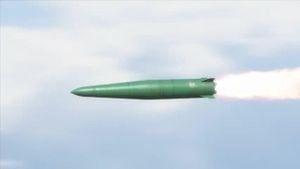SpaceX recently pulled off what can only be described as one of the most daring and high-stakes space missions to date. On Sunday morning, the aerospace company launched its Super Heavy-Starship rocket from the Boca Chica facility in Texas, at exactly 8:25 AM EDT. Designed to be the largest and most powerful rocket ever made, it showcases SpaceX's ambitions for deep space exploration, particularly its goal to make life multiplanetary.
What made this flight particularly remarkable wasn't just the launch itself, impressive as it may be. The highlight of the event came during the landing phase when SpaceX used its towering "mechazilla" robotic arms to catch the descending Super Heavy booster mid-air. This method of capturing the rocket on its return to the launch pad is unprecedented and signifies a major leap forward for the company’s reusable rocket technology. "Big step toward making life multiplanetary was made today," remarked SpaceX founder Elon Musk on his social media platform, X.
The 397-foot rocket blasted off, producing quite the spectacle as its 33 Raptor engines roared to life, sending up enormous plumes of flames and smoke against the backdrop of the rising sun. Just three minutes and 40 seconds post-launch, the Super Heavy booster was detached to continue its mission back to the launch site. After flipping around and reigniting some of its engines, it executed its descent toward the pad.
But it wasn’t just about catching the booster. The upper stage of the Starship performed admirably too. It looped around our planet and re-entered the atmosphere over the Indian Ocean. Throughout its fiery descent, it faced extreme heat—up to 3,000 degrees—but emerged relatively unscathed thanks to its improved heat shield tiles and well-functioning steering fins. This showcases the advancements SpaceX has made since previous test flights, where similar re-entry procedures had caused considerable damage to the craft.
Upon reaching the Indian Ocean, the Starship completed its mission by executing what is described as a controlled splashdown, albeit under less-than-ideal conditions since it is not intended to land on water. The cameras onboard captured the entirety of this event, illuminating the dazzling sight of the ship burning up upon reentry and splashing down, followed by what appeared to be a minor explosion after hitting the water. Nevertheless, this sequence confirmed the flight as successful.
Elon Musk's vision for the Super Heavy-Starship model is all about reusability. Powered by 6.8 million pounds of liquid oxygen and methane, the rocket aims for rapid refurbishment, allowing for quick turnarounds to launch subsequent missions. Following the methodology perfected with the Falcon 9, which has successfully recovered over 350 boosters, Musk aims to achieve similar, if not improved, capabilities with the Starship system.
During prior flights, particularly one held back in June, the extreme temperatures devastately impacted the Starship's protective thermal tiles and steering systems. Spurred by the findings from those attempts, SpaceX made considerable upgrades leading up to this recent test. These modifications allowed for the latest flight to endure the high-stress conditions more effectively, which was instrumental as the Starship maneuvered back toward Earth.
Looking at the specifications, the Super Heavy booster stands 230 feet tall and features 33 specialized Raptor engines generating upwards of 16 million pounds of thrust. For comparison, this is more powerful than NASA's historic Saturn V and its latest Space Launch System combined. While initial launches were complicated, years of engineering and testing have culminated in the design we see today.
Both the Super Heavy booster and the Starship upper stage are built with the hope of full reusability. Each entity is crafted for independent functionality—while the Super Heavy makes its way back to the launch pad, the Starship aims to reach orbit and, eventually, extraterrestrial bodies like the Moon and Mars. Musk has indicated aspirations for the Starship to perform vertical landings, underscoring his vision for interplanetary travel.
While the success of recent flights brings excitement, there’s still much work to be done. SpaceX is concurrently under contract with NASA, developing the Starship to assist with lunar landings as part of the Artemis program, expected to send astronauts back to the Moon by 2027-28. Rapid reusability will play a key role here, considering the number of tankers required to refuel the Starship before it heads toward lunar orbit.
Despite the triumphs, Musk has raised concerns about the role of the Federal Aviation Administration (FAA) and its lengthy approval process for launch licenses, which he believes is stifling innovation. Just before the latest test flight, the FAA granted SpaceX the necessary license, but it wasn’t without scrutiny. Musk said, "The agency’s bureaucracy takes too long to review and approve launch licenses. This may affect the overall speed and efficiency of innovative advancements."
The ideal future for SpaceX is not just about successfully launching missions but creating sustainable processes for rapidly reusing rockets, paving the way for more regular—and far-reaching—space exploration. Each test flight yields invaluable data and experience, moving the company closer to realizing its dreams.
With every increment of progress, it's clear SpaceX continually pushes the limits of what space travel can be. Following the remarkable offers so far, everyone's eyes are turned toward what happens next on this path toward making life multiplanetary. Undoubtedly, the stakes remain high, but so do the potential rewards for humanity's venture beyond our planet.



